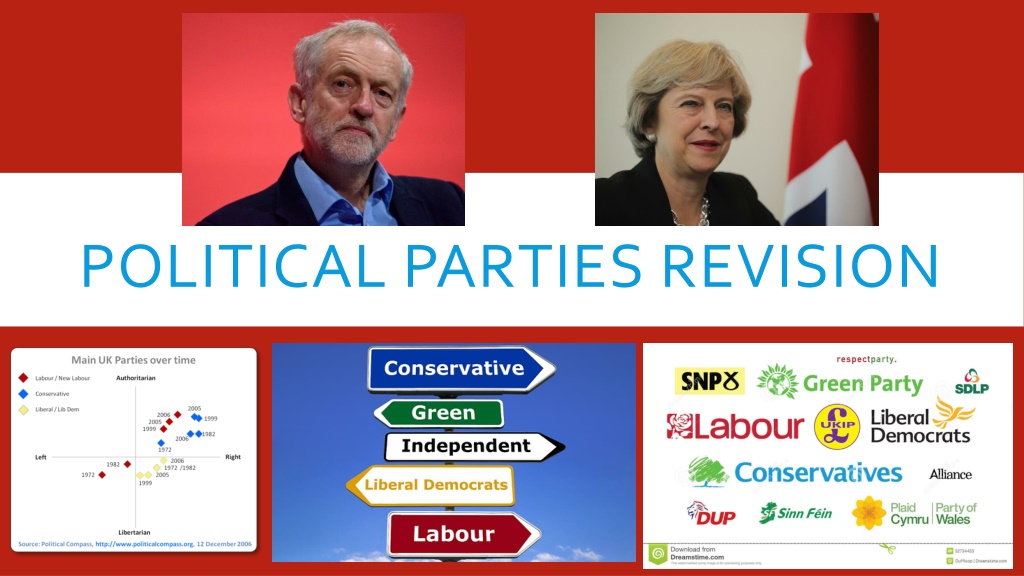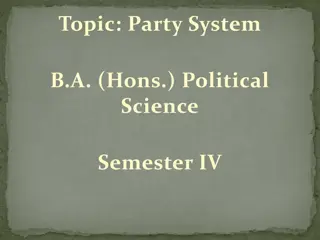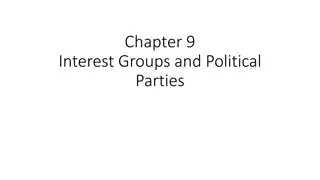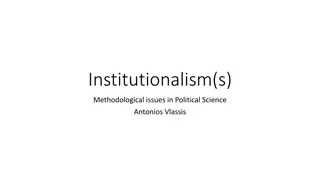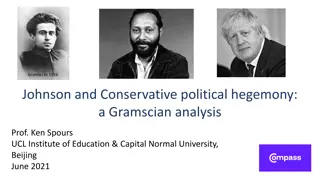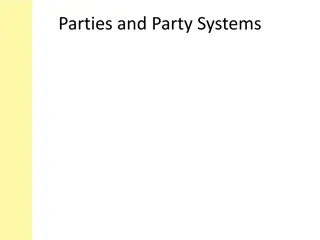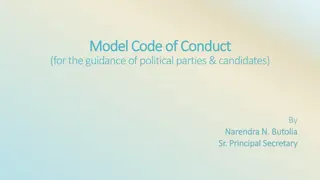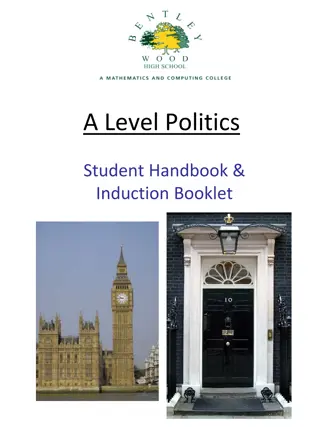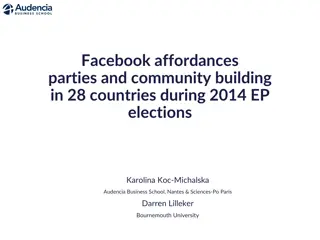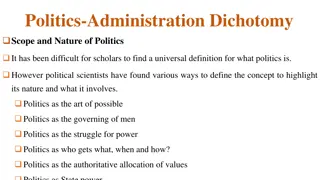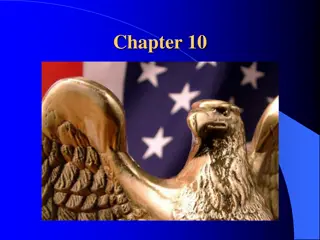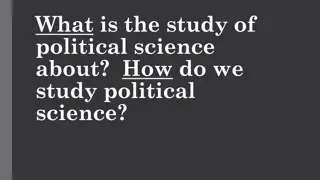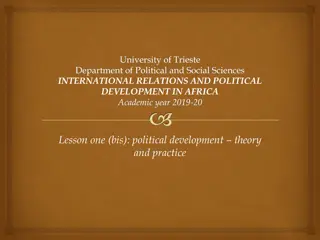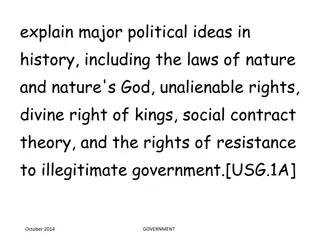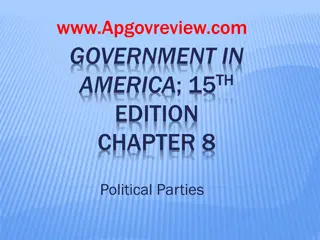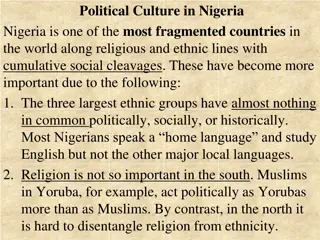Understanding Political Parties and Factional Politics
Political parties are groups with shared values aiming to win power through elections. They produce manifestos outlining their policies. Factions within parties may support different leaders or policies, influencing party dynamics. Parties play essential roles in shaping government policies and engaging citizens through elections. Adversary and consensus politics represent contrasting approaches in policy-making and governance.
Download Presentation

Please find below an Image/Link to download the presentation.
The content on the website is provided AS IS for your information and personal use only. It may not be sold, licensed, or shared on other websites without obtaining consent from the author. Download presentation by click this link. If you encounter any issues during the download, it is possible that the publisher has removed the file from their server.
E N D
Presentation Transcript
KEY TERMS Political Party Party Government Manifesto and Mandate Factions Right vs. Left Wing ideas Consensus politics Adversarial Politics
WHAT IS A POLITICAL PARTY? Group of like-minded people who attempt to win political power through elections. Disraeli said, Party is organised opinion . Will generally have a broad ideological identity its members will share basic values and goals. At elections they will produce a policy programme known as a manifesto. It will also have a broad policy focus (catch all), since (if it is a major party) it must convince the electorate that it can take on the task of government. Smaller parties may be more programmatic in nature i.e. Much more fixed opinions (ideological) focussing on particular issues.
PARTY FACTIONS A group of like minded politicians, usually formed around a key leader or in support of a particular set of policies preferences. Labour party factions: Labour First more right-wing group of labour Party backed Anyone But Corbyn in both leadership races Progress moderate group of MPs (Blairite) Momentum Corbyn supporting and increasingly powerful
PARTY FACTIONS A group of like minded politicians, usually formed around a key leader or in support of a particular set of policies preferences. Conservative Party factions With the Conservatives, it s now easiest to approach this from a Brexit point of view, those in favour of a hard Brexit vs those in favour of a soft one The hard Brexit Conservatives MPs are focussed around Boris Johnson & Jacob Rees- Mogg Whilst the soft MPs are led by MPs such as Anna Soubry
CORE FUNCTIONS OF POLITICAL PARTIES (10) (THINK PROPER !) Policy function Representative function: Organisation of Government: Participatory function. Elections:
ADVERSARY VS CONSENSUS POLITICS What is meant by Adversary Politics?
ADVERSARY VS CONSENSUS POLITICS Adversary Politics The broader meaning of adversary politics is when there is a wide and clear gulf between the policies of main parties e.g. the 1980s was a great period of adversary politics in Britain, when Thatcherism was confronted by a very left wing Labour Party. Potentially the advent of Corbynas leader of the Labour party means that this is coming back?
ADVERSARY VS CONSENSUS POLITICS What is meant by Consensus Politics?
ADVERSARY VS CONSENSUS POLITICS Consensus Politics- One meaning is that the main political parties adopt policies which are similar and overlap a great deal. That is, there is a broad consensus over most key political issues. This is likely to reflect broader opinion among the electorate. With consensus politics, political conflict tends to concern such issues as policy detail, how to deliver policies and the competence or otherwise of the government and opposition, but not over the main issues. Generally agreed that the 50s and 60s ( Butskellism ) and the period since 2005 = consensus politics. This arguably reached its peak during the Coalition
main UK political party logos IDEOLOGIES Conservatism Socialism Liberalism Definition: An ideology (political belief) that is defined by a desire to conserve . It places faith in tradition, experience and history. Its defining values are: Definition: The central idea of socialism is that people are social creatures who are bound together by common humanity. Its defining values are: Definition: An ideology that is defined by a commitment to the individual based on an idea of natural human rights. Its defining values are: Tradition respect for traditional ideas and practices Human Imperfection belief that people are self-seeking Hierarchy and authority top down social organisation Fraternity brotherhood or sympathy between people Cooperation people working together rather than competing against one another Equality Abolish or reduce class division Individualism the individual is of supreme importance Freedom individuals should be as free as possible without affecting the freedom of others Toleration people should be willing to accept ideas and practices they disapprove of
MAIN AREAS OF CONSENSUS (SIMILARITIES) BETWEEN THE MAIN PARTIES
MAIN AREAS OF CONSENSUS (SIMILARITIES) BETWEEN THE MAIN PARTIES. Health/NHS. All main parties agree that the NHS is an institution that needs funding and supporting. Whilst they disagree on the inner workings of it, they do both want to keep it broadly free at the point of access. Social Policy. General consensus between three main parties that there is a need for policies to combat family breakdown, deprivation in poorer areas and lack of opportunity for the young. There is also a general sense that general inequality and lack of social justice need to be addressed. Disagreement is confined to methods rather than priorities. Environment. All three parties agree that environmental protection is a priority, especially climate change and the need for renewable energy production. Conflict is confined to details of policy and which renewables are most appropriate, with some disagreement over nuclear energy. Brexit Both Labour and Tories believe that the referendum result should be honoured they do however differ on what type of Brexit we should have (Hard or soft)- it is only the Liberal Democrats who don t believe this.
MAIN AREAS OF DIFFERENCE BETWEEN THE THREE MAIN PARTIES.
MAIN AREAS OF DIFFERENCE BETWEEN THE MAIN PARTIES. Main areas of difference between the parties Cutting the deficit. The Coalition still wants to cut harder and faster than Labour. This is particularly true now Corbyn has taken over as Labour leader. Crime. Conservatives see personal responsibility rather than social causes as the basis of crime and their response to the Summer 2011 riots was one emphasising the role of punishment. Education. Over Free Schools, grammar schools, tuition fees, Academies and the role of Local Authorities, there is now considerable difference in policy across the parties. Tax. Conservatives have a tax-cutting inclination and have continued this after the 2015 election. The 2017 budget included a range of tax cutting policies.
MAIN AREAS OF DIFFERENCE BETWEEN THE MAIN PARTIES. Main areas of difference between the parties Welfare State. There are some disagreements over the detailed operation of welfare services. Iain Duncan-Smith has introduced significant changes to the welfare system (including capping housing benefit, capping the amount of benefits any family can receive and reducing the rise in other benefits to below inflation levels). Role of the State.Labour favours an interventionist or Enabling State. The Conservatives have criticised this heavily calling it a nanny state . They favour a minimal state which empowers local communities (including voluntary groups and businesses etc) to take local action themselves. Cameron has said he wants to wage war on the state in favour of his Big Society . Foreign Policy Airstrikes In Syria, foreign wars and defence policy, i.e. Trident (Although JC is against Labour is so be careful with this one
CONCLUSION TO WHAT EXTENT ARE THE MAIN PARTIES DIVIDED?
LEFT WING IDEAS Historically based on socialist principles: equality, collectivism, redistributive taxation and the welfare state Left wing refers to socialism or social democracy. Labour is known as both a socialist and a social democrat party. Left wing means a preference for the public sector. Labour tends to favour a balance towards the public sector in the provision of services. Public ownership Corbyn renationalise railways and energy companies. Left wing implies support for equality and equality of opportunity. Labour traditionally supports both. A National Education Service, following the NHS model, would be established. State-funded academies and free schools would be forced to return to local authority control.
IDEALS AND BELIEFS OF LABOUR Main Beliefs and Policies of the Labour Party Historically based on socialist principles: equality, collectivism, redistributive taxation and the welfare state Labour now accepts that economic activity should be based largely on free markets. The role of the state is now more flexible an Enabling State focusing on delivering Equality of Opportunity. Combating inflation is a key priority, as is the promotion of en enterprise culture. They believe that the best response to poverty is not to redistribute income from rich to poor, but to offer tax credits to the deserving poor those on low pay, seeking work, poor pensioners, or families with children. Welfare benefits should be an incentive to work not a disincentive (e.g. Welfare to Work schemes) Education at all levels nursery, primary, secondary and higher is a priority and is seen as the best way to spread opportunity more evenly and to create a more effective, wealth creating workforce. It is also seen as a weapon against youth crime. Labour opposes the rise in tuition fees to 9,000. Health provision free to all, equal and comprehensive, funded largely out of taxation. However, they believe the private sector should be involved when this creates better value for money or effective, faster treatment. The reduction of poverty, especially among children and pensioners, is a key priority, with ambitious targets for poverty reduction being adopted. Tax hikes on earnings over 150,000 (50%) to help fund this.
LABOUR UNDER CORBYN RETURNED TO/ABANDONED TRADITIONAL PRINCIPLES? Returning to Old Labour Elements of New Labour remain Economy in particular taxation Foreign policy disagreements Nationalisation Environment Education Similar on immigration State spending MPs still remain largely New Labour
RIGHT WING IDEAS There are various political ideas which are considered to be right wing some of which include: Right wing political ideas stress a reduction in the role of the state and as such we see the reduction of the role of welfare and social security in the lives of the individual cuts to disability allowance under Tories. Right wing political ideas stress the importance of private ownership in business and for home ownership. There is a preference for privatisation of state assets. Privatisation of state industry Thatcher (BT and BR) Right wing ideas stress the promotion of a free market with minimal interference from the state. Reducing top rate of tax. Right wing ideas emphasise the need for authority and thus stress law and order as priorities in society and therefore we see policies linked to punishment and retribution for crime and criminals (More police officers on the street, clamp down on illegal immigration/deportation)
ONE NATION CONSERVATISM (OR TRADITIONAL CONSERVATISM) VS THATCHERISM WHICH IS WHICH? One Nation Conservatism believes that government has a responsibility to maintain the welfare of all the people and should interfere to achieve that. They see society not as a collection of individuals but rather as an organic whole (the organic society ), where everyone s interests are interrelated. This has led to a belief in paternalism . Thatcherism is typified by the belief in the strong individual and a strong economy. This equates to neoconservatism and neoliberalism . Neo conservatism is the belief in robust moral values and an authoritarian state. Neoliberalism is the term used to describe laissez- faire or free market economic ideas.
TORIES UNDER MAY ONE NATION OR THATCHERITE? Thatcherite One Nation Tax Health Pension Education Immigration (neo-Conservatism, British values) Housing EU to an extent Workers rights - national living wage
CONCLUSION TO WHAT EXTENT IS THE CURRENT CONSERVATIVE PARTY THATCHERITE IN NATURE?
